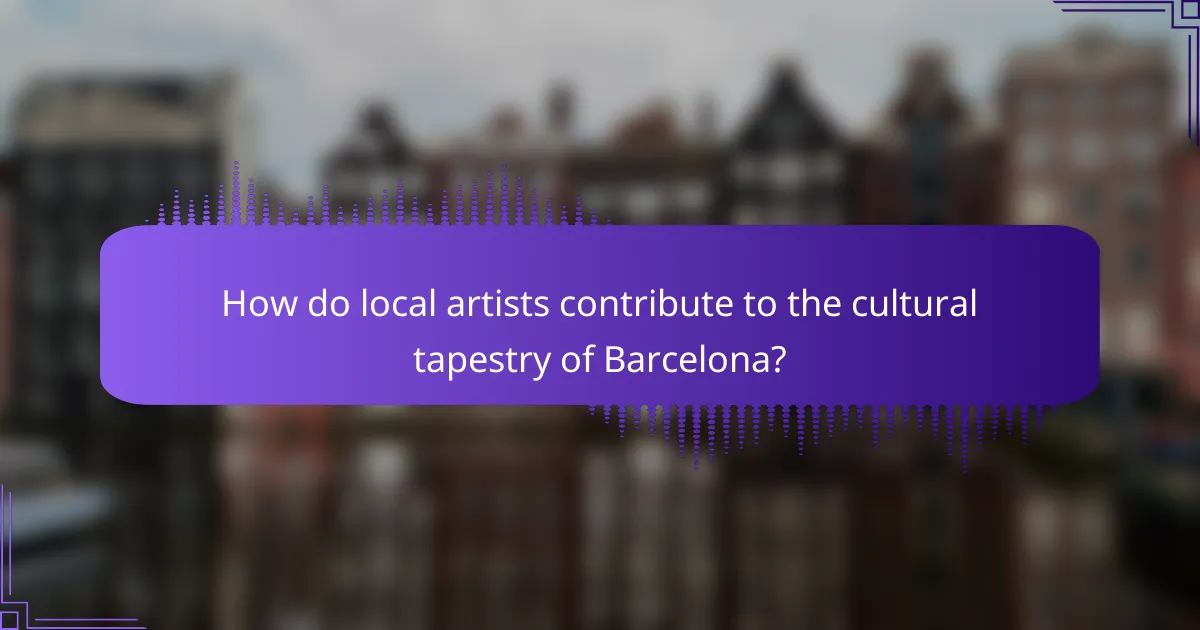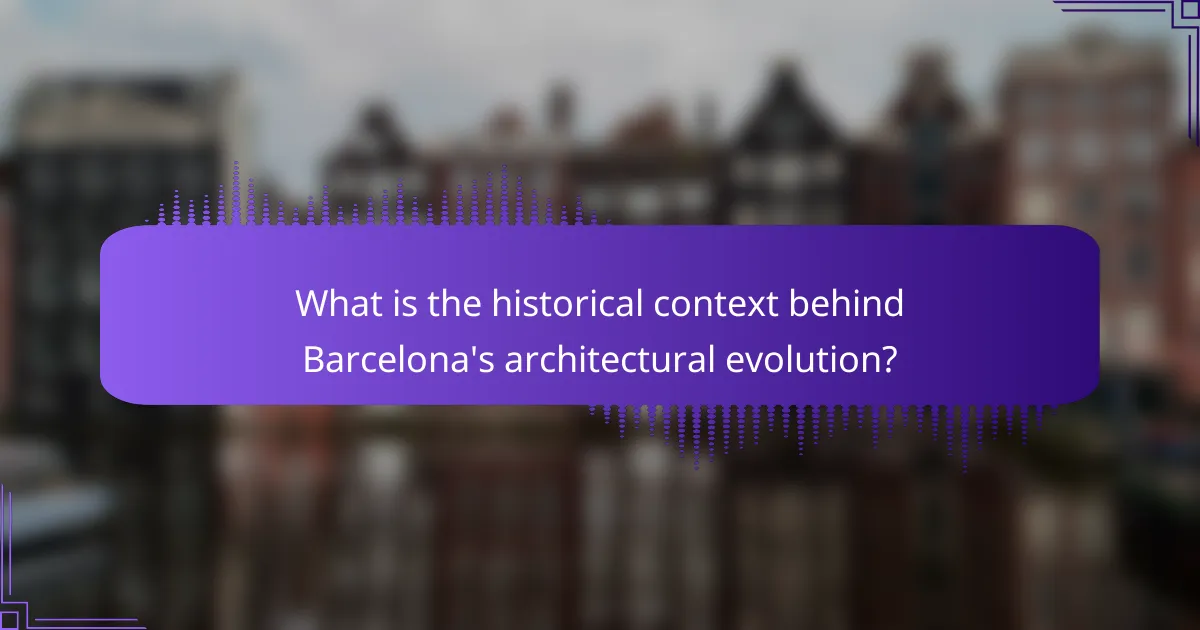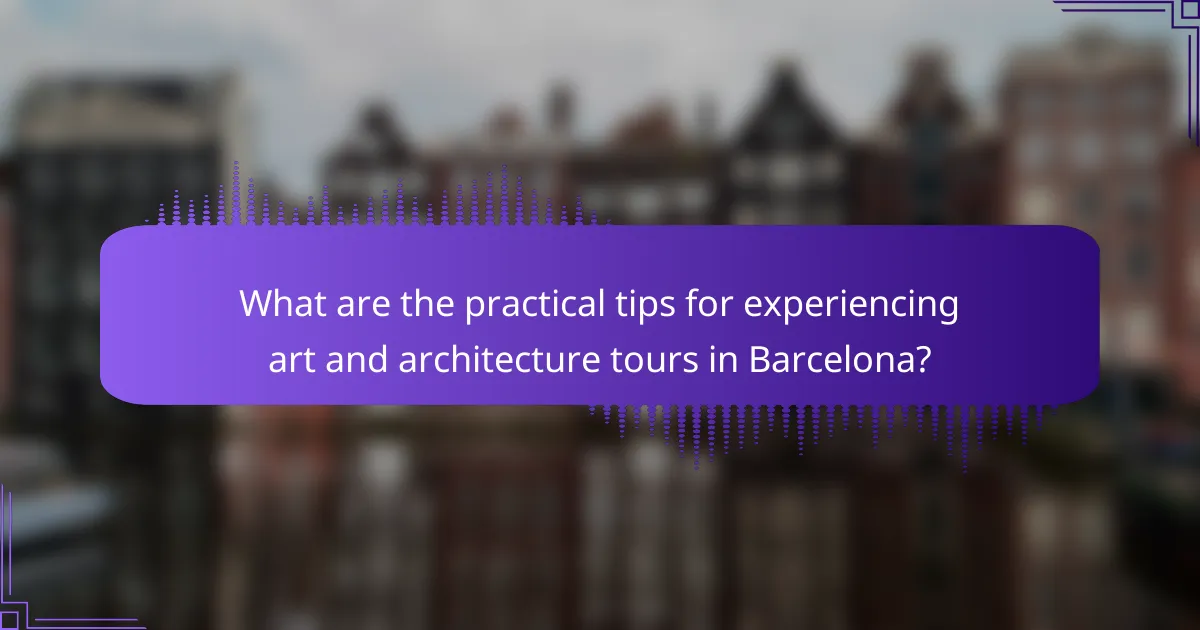Discover the unique art and architecture tours in Barcelona that showcase iconic landmarks, local artists, and the city’s rich historical context. Explore the intricate designs of Antoni Gaudí, including the Sagrada Familia and Park Güell. Engage with contemporary street art and learn about the cultural evolution reflected in the Gothic Quarter. Experience immersive storytelling that deepens your understanding of Barcelona’s vibrant artistic heritage.
![]()
What are the key iconic landmarks in Barcelona that define its art and architecture?
Barcelona’s key iconic landmarks that define its art and architecture include the Sagrada Familia, Park Güell, Casa Batlló, and the Gothic Quarter. These sites reflect the city’s unique blend of modernist and historical styles.
The Sagrada Familia, designed by Antoni Gaudí, showcases intricate facades and towering spires, making it a UNESCO World Heritage Site. Park Güell features vibrant mosaics and organic shapes, embodying Gaudí’s innovative approach. Casa Batlló stands out with its skeletal design and colourful tiles, representing the Catalan Modernisme movement. The Gothic Quarter, with its medieval streets and historic buildings, offers a glimpse into Barcelona’s rich past.
These landmarks not only highlight artistic creativity but also provide insight into the cultural evolution of Barcelona. Each site contributes to the city’s identity, making art and architecture tours a captivating experience.
How does Gaudí’s influence shape the city’s architectural landscape?
Gaudí’s influence profoundly shapes Barcelona’s architectural landscape through his unique style and innovative techniques. His use of organic forms, vibrant colours, and intricate details reflects the city’s identity. Landmark structures like the Sagrada Familia and Park Güell showcase his ability to harmonise architecture with nature. These sites attract millions of art and architecture enthusiasts, emphasising the significance of Gaudí’s vision in contemporary urban design. The fusion of modernism and traditional Catalan elements in his work continues to inspire local artists and architects.
Which lesser-known landmarks offer unique artistic insights?
Lesser-known landmarks in Barcelona, such as the Hospital de Sant Pau and the Palau de la Música Catalana, offer unique artistic insights. The Hospital de Sant Pau features stunning modernist architecture by Lluís Domènech i Montaner, showcasing intricate mosaics and stained glass. The Palau de la Música Catalana, a UNESCO World Heritage site, is renowned for its breathtaking concert hall adorned with vibrant sculptures and mosaics, reflecting Catalan modernism’s artistic spirit. Exploring these sites enriches understanding of Barcelona’s cultural heritage.

How do local artists contribute to the cultural tapestry of Barcelona?
Local artists significantly enrich Barcelona’s cultural tapestry through their unique contributions to art and architecture. Their works often reflect the city’s diverse history and vibrant community.
Artists like Joan Miró and Antoni Gaudí have left lasting legacies, influencing both local and international art scenes. Street art in neighbourhoods like El Raval showcases contemporary expressions, while traditional crafts are preserved in areas such as Gràcia.
These artists engage with local culture, creating a dialogue that enhances community identity and pride. Their involvement in festivals and public art projects fosters collaboration and innovation, making art accessible to all.
As a result, local artists not only beautify the city but also play a crucial role in preserving and evolving Barcelona’s cultural heritage.
What are the notable contemporary artists and their works?
Notable contemporary artists in Barcelona include Antoni Gaudí, known for his unique architectural style, and Joan Miró, celebrated for his vibrant paintings. Their works reflect the city’s rich artistic heritage and innovative spirit. Gaudí’s Sagrada Família exemplifies organic architecture, while Miró’s murals at the Fundació Joan Miró showcase surrealism. Other prominent artists include Antoni Tàpies, whose abstract works often incorporate mixed media, and modern street artists like Blu, known for large-scale murals. These artists contribute significantly to Barcelona’s cultural landscape, making it a hub for art enthusiasts.
How do traditional artists preserve local heritage?
Traditional artists preserve local heritage by integrating cultural narratives into their artworks. They often utilise techniques passed down through generations, reflecting historical contexts and local customs. In Barcelona, artists contribute to heritage preservation by creating murals and sculptures that celebrate the city’s architectural legacy. These works not only enhance the urban landscape but also educate visitors about the significance of local history and traditions. Additionally, collaborative projects with communities ensure that diverse voices are represented, enriching the cultural tapestry of the region.

What is the historical context behind Barcelona’s architectural evolution?
Barcelona’s architectural evolution reflects a rich historical context shaped by various artistic movements and cultural influences. Over centuries, the city has transitioned from Roman foundations to Gothic structures and modernist masterpieces. The Catalan Modernisme movement, led by figures like Antoni Gaudí, introduced innovative designs, blending nature with architecture. Significant landmarks, such as the Sagrada Família and Park Güell, exemplify this unique style. Additionally, the city’s architecture reveals its socio-political history, with buildings representing different eras and ideologies, making Barcelona a living museum of architectural diversity.
How did the Gothic Quarter influence modern design?
The Gothic Quarter significantly influenced modern design through its intricate architectural styles and historical elements. Its medieval structures, such as the Barcelona Cathedral, inspire contemporary architects to blend tradition with innovation. The use of pointed arches and detailed facades in the Gothic Quarter has led to a resurgence of these elements in modern urban spaces. Local artists draw from the area’s rich history, incorporating its aesthetic into their work, thereby creating a dialogue between the past and present. As a result, the Gothic Quarter serves as a living museum, influencing design trends and artistic expressions globally.
What role did the 1992 Olympics play in urban development?
The 1992 Olympics significantly transformed urban development in Barcelona. The event catalysed infrastructure improvements, including transportation and public spaces, enhancing the city’s global appeal. Iconic landmarks, such as the Olympic Stadium and the waterfront redevelopment, emerged from this transformation. Local artists and architects contributed to the city’s cultural renaissance, making Barcelona a hub for art and architecture tours. The legacy of the Olympics continues to shape the city’s identity and attract visitors.

Which art and architecture tours provide the best immersive experiences?
Art and architecture tours in Barcelona offering immersive experiences include those that focus on local artists, iconic landmarks, and historical context. These tours enhance understanding through engaging storytelling and interactive elements.
One notable option is the Gaudí-focused tour, which delves into the unique architectural style of Antoni Gaudí, highlighting landmarks like the Sagrada Família and Park Güell. Another immersive choice is the Gothic Quarter tour, where participants explore medieval architecture while learning about the area’s rich history.
Additionally, street art tours provide insight into contemporary local artists, showcasing vibrant murals and installations. Culinary art tours that combine food experiences with visits to art galleries also enrich the overall cultural understanding.
Overall, selecting a tour that combines expert guides, interactive elements, and a focus on both historical and contemporary aspects will yield the best immersive experience.
What should you expect from guided versus self-guided tours?
Guided tours offer expert insights and structured experiences, while self-guided tours provide flexibility and independence. Guided tours in Barcelona’s art and architecture highlight iconic landmarks and local artists, enriching the historical context. Self-guided tours allow for personalised exploration at your own pace. Guided options often include access to exclusive sites and knowledgeable guides, enhancing the overall experience.
How do themed tours enhance understanding of the city’s culture?
Themed tours significantly enhance understanding of Barcelona’s culture by providing immersive experiences. These tours focus on iconic landmarks, local artists, and historical context, allowing participants to connect deeply with the city’s artistic heritage.
Art and architecture tours reveal the unique attributes of Barcelona’s buildings, such as Antoni Gaudí’s distinct style, which blends nature with innovative design. Participants learn about the historical significance of each landmark, enriching their appreciation for the city’s evolution.
Local artists often guide these tours, sharing personal insights and stories that highlight the cultural vibrancy of neighbourhoods. This interaction fosters a deeper connection to the community and its artistic endeavors.
As a result, themed tours serve as an engaging educational platform, transforming visitors into informed advocates of Barcelona’s rich cultural tapestry.

What are the practical tips for experiencing art and architecture tours in Barcelona?
To experience art and architecture tours in Barcelona effectively, prioritise guided tours that highlight iconic landmarks and local artists. Engage with historical context to enhance your understanding.
Consider visiting during off-peak hours for a more intimate experience. Utilise public transport to access various sites efficiently. Take notes or photographs to capture details and insights.
Explore lesser-known galleries and street art to appreciate the city’s vibrant artistic scene. Participate in workshops with local artists for hands-on learning.
How can you optimize your itinerary for maximum cultural exposure?
To optimize your itinerary for maximum cultural exposure in Barcelona, focus on diverse art and architecture tours. Prioritise iconic landmarks, engage with local artists, and immerse yourself in the historical context of each site.
Explore the Sagrada Familia for its unique blend of Gothic and Art Nouveau styles. Visit the Picasso Museum to appreciate local artistry and historical significance. Join guided tours that highlight lesser-known galleries and street art to gain deeper insights into Barcelona’s vibrant culture.
Consider timing your visits to coincide with local festivals or art events, enhancing your experience with authentic cultural interactions. Use public transportation to navigate the city efficiently, allowing more time for exploration.
By strategically selecting tours and experiences, you can maximize your cultural exposure and create a rich, memorable itinerary in Barcelona.
What common mistakes should you avoid during your tours?
To enhance your experience on art and architecture tours in Barcelona, avoid these common mistakes.
1. Ignoring local artists: Engage with their work for deeper insights into the city’s culture.
2. Skipping historical context: Understanding the background of landmarks enriches appreciation.
3. Overlooking guided tours: Expert guides provide valuable information and context that self-guided tours may miss.
4. Rushing through sites: Take time to absorb the details of iconic landmarks and their significance.
5. Neglecting to plan: Researching tour options and schedules helps maximize your time and experience.
Which resources can help you explore beyond the typical tourist path?
Art and architecture tours in Barcelona offer unique insights beyond typical tourist paths. Local guides often highlight lesser-known landmarks and the works of emerging artists.
Exploring neighbourhoods like Gràcia or El Raval reveals street art and community projects. These tours often delve into historical contexts, showcasing how art reflects the city’s evolution.
Engaging with local artists through workshops or studio visits enhances the experience. Participants gain a deeper appreciation of Barcelona’s creative scene while supporting local talent.
Additionally, specialized tours may focus on specific themes, such as modernist architecture or contemporary art, providing a tailored exploration of the city’s diverse artistic heritage.